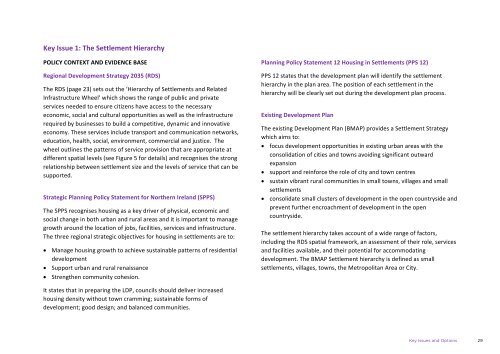Local Development Plan
2oBkyQa
2oBkyQa
You also want an ePaper? Increase the reach of your titles
YUMPU automatically turns print PDFs into web optimized ePapers that Google loves.
Key Issue 1: The Settlement Hierarchy<br />
POLICY CONTEXT AND EVIDENCE BASE<br />
Regional <strong>Development</strong> Strategy 2035 (RDS)<br />
The RDS (page 23) sets out the ‘Hierarchy of Settlements and Related<br />
Infrastructure Wheel’ which shows the range of public and private<br />
services needed to ensure citizens have access to the necessary<br />
economic, social and cultural opportunities as well as the infrastructure<br />
required by businesses to build a competitive, dynamic and innovative<br />
economy. These services include transport and communication networks,<br />
education, health, social, environment, commercial and justice. The<br />
wheel outlines the patterns of service provision that are appropriate at<br />
different spatial levels (see Figure 5 for details) and recognises the strong<br />
relationship between settlement size and the levels of service that can be<br />
supported.<br />
Strategic <strong>Plan</strong>ning Policy Statement for Northern Ireland (SPPS)<br />
The SPPS recognises housing as a key driver of physical, economic and<br />
social change in both urban and rural areas and it is important to manage<br />
growth around the location of jobs, facilities, services and infrastructure.<br />
The three regional strategic objectives for housing in settlements are to:<br />
• Manage housing growth to achieve sustainable patterns of residential<br />
development<br />
• Support urban and rural renaissance<br />
• Strengthen community cohesion.<br />
<strong>Plan</strong>ning Policy Statement 12 Housing in Settlements (PPS 12)<br />
PPS 12 states that the development plan will identify the settlement<br />
hierarchy in the plan area. The position of each settlement in the<br />
hierarchy will be clearly set out during the development plan process.<br />
Existing <strong>Development</strong> <strong>Plan</strong><br />
The existing <strong>Development</strong> <strong>Plan</strong> (BMAP) provides a Settlement Strategy<br />
which aims to:<br />
• focus development opportunities in existing urban areas with the<br />
consolidation of cities and towns avoiding significant outward<br />
expansion<br />
• support and reinforce the role of city and town centres<br />
• sustain vibrant rural communities in small towns, villages and small<br />
settlements<br />
• consolidate small clusters of development in the open countryside and<br />
prevent further encroachment of development in the open<br />
countryside.<br />
The settlement hierarchy takes account of a wide range of factors,<br />
including the RDS spatial framework, an assessment of their role, services<br />
and facilities available, and their potential for accommodating<br />
development. The BMAP Settlement hierarchy is defined as small<br />
settlements, villages, towns, the Metropolitan Area or City.<br />
It states that in preparing the LDP, councils should deliver increased<br />
housing density without town cramming; sustainable forms of<br />
development; good design; and balanced communities.<br />
Key Issues and Options 29


